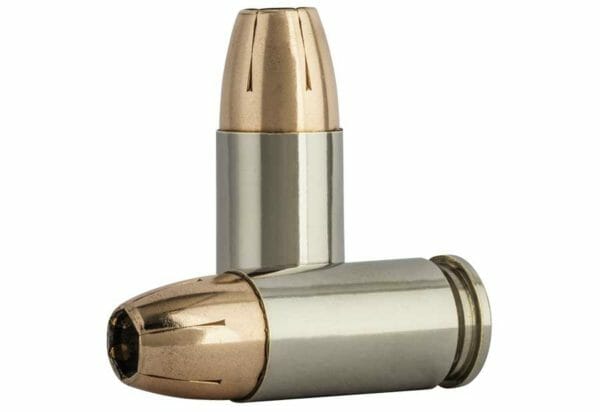
When it comes to ammunition, not all rounds are created equal. However, there’s a common misconception among gun owners, particularly the less experienced ones, about the interchangeable use of range and self-defense ammunition. This notion could not be further from the truth, and understanding the critical differences is essential for anyone serious about their firearm proficiency and safety.
The Misguided Belief in Range Ammo for Self-Defense
Range ammunition, like full metal jacket (FMJ) or fragmenting rounds, is generally unsuitable for self-defense. Although it’s tempting to consider range ammo due to its lower cost and availability, this decision could be detrimental in a real-world scenario. But why?
The primary issue lies in the behavior of range ammo upon impact. Unlike self-defense ammunition, range rounds tend to over-penetrate. This means they can pass through a target and potentially harm unintended targets, a significant risk in urban or suburban environments. While the military uses FMJ rounds due to historical conventions and a different operational context, civilians need to consider the immediate implications of their ammunition choice.
Readers, before you continue you might want to scroll down to the bottom and review our overview of self defense calibers or ammunition as well as our handy set of definitions for various types of ammunition rounds and their attributes.
The Superiority of Self-Defense Ammo
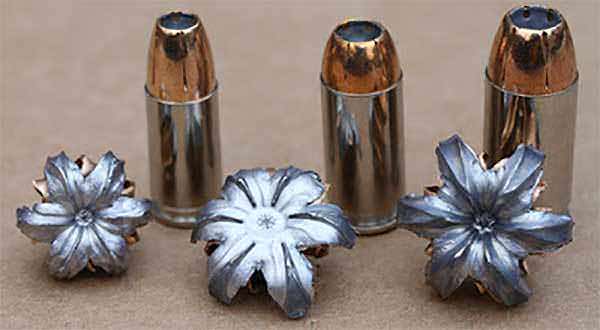
Self-defense ammunition, including types like hollow points and other expanding rounds, is crafted with a specific and critical purpose in mind. Unlike range ammunition, these rounds are designed to deliver maximum effectiveness in stopping a threat while minimizing over-penetration risks. Upon impact, these rounds undergo a controlled expansion, creating a significantly larger wound channel in the target. This expansion is a key factor in their effectiveness, as it not only causes greater damage to the assailant but also slows the bullet down, drastically reducing its potential to exit the target and cause unintended harm.
The design of hollow point bullets exemplifies this principle. On impact, the hollow tip of the bullet expands, leading to a rapid transfer and dissipation of energy into the target. This expansion increases the diameter of the bullet, maximizing the damage within the assailant and thus quickly reducing their capability to sustain an attack. The rapid energy transfer and expansion also significantly decrease the chance of the bullet exiting the target and endangering others, a critical consideration in densely populated or residential areas. This characteristic makes hollow points a preferred choice in many self-defense scenarios, balancing the need for effective threat neutralization with the responsibility to minimize collateral damage.
Furthermore, this design philosophy underscores a fundamental aspect of responsible ammunition choice for self-defense. By opting for rounds that are specifically engineered to stop an assailant with reduced risk of collateral damage, users demonstrate a commitment to safety and efficacy. This approach is not just about choosing the right tool for the job; it’s about understanding the dynamics and potential consequences of a defensive shooting scenario.
Cost vs. Safety: A Misleading Trade-off
The argument for using range ammunition often centers on its cost-effectiveness. However, this view is short-sighted. Self-defense rounds are indeed more expensive, but for good reason: they are specifically engineered for reliability and effectiveness in critical situations. This higher cost reflects their specialized design, offering improved stopping power and reduced risk of over-penetration.
In the context of self-defense, where the stakes are personal safety, perhaps even life and death, the choice of ammunition is paramount. Opting for cheaper-range ammo for self-defense is like compromising on the quality of brakes for a sports car – it’s a risk to essential safety. It’s not just a purchase; it’s an investment in reliable performance when it matters most.
The Case of Shotguns and Smaller Calibers for Home Defense
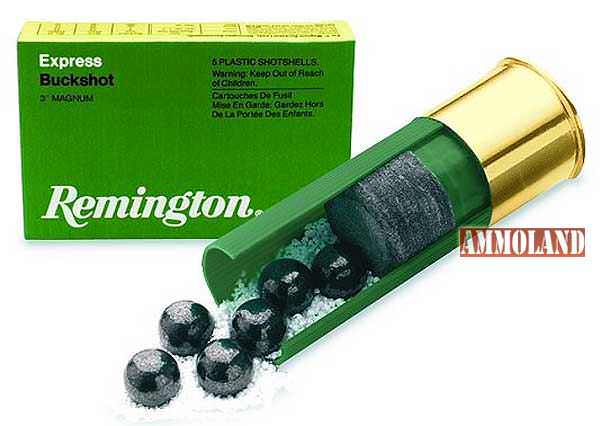
Ammunition choice for shotguns and small-caliber pistols is crucial in self-defense discussions. Birdshot or target loads, often used in shotguns, lack the necessary stopping power for home defense compared to buckshot or slugs. Buckshot provides a wider impact area, essential in close-range defense, while slugs offer deep penetration and significant impact force for neutralizing threats.
Small-caliber handguns, like .380 or .32 ACP, are favored for their lower recoil and concealability. However, they may not always offer the best balance between power and manageability. Compact 9mm pistols have emerged as a more popular choice, offering effective stopping power with manageable recoil and making them suitable for a wide range of self-defense scenarios.
In choosing self-defense firearms and ammunition, it’s important to balance personal comfort with the capability to neutralize threats effectively. The selection should prioritize ammunition that is powerful enough to stop a threat while minimizing risks to bystanders.
9mm Self-Defense Ammunition Is Also Known As An Effective Defense Against Bears.
Read Related: Grizzly Bear Attack in Montana Stopped with 9mm Pistols
Live Inventory Price Checker
|
|
Federal Syntech Defense 9mm Ammunition, 50 Rounds JHP 138gr - S9SJT2 | Palmetto State Armory | $ 49.99 $ 36.49 |
|
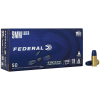
|
Federal Syntech Defense 9mm Ammunition, 50 Rounds JHP 138gr - S9SJT2 | Palmetto State Armory | $ 49.99 $ 36.49 |
|
|
|
DoubleTap Bonded Defense 9mm Ammunition, 20 Rounds JHP 115Gr - 9MM115BD | Palmetto State Armory | $ 35.99 $ 25.49 |
|

|
DoubleTap Bonded Defense 9mm Ammunition, 20 Rounds JHP 115Gr - 9MM115BD | Palmetto State Armory | $ 35.99 $ 25.49 |
|
When it comes to self-defense ammunition, various brands manufacture specific lines designed for optimal performance in defensive situations. Here’s a list of some popular caliber choices along with notable brands and specific models of self-defense ammunition:
- 9mm Luger:
- Federal Premium HST: Known for its consistent expansion and penetration.
- Speer Gold Dot: Highly regarded by law enforcement, offers excellent performance.
- Hornady Critical Defense: Designed for reliable expansion and minimal risk of over-penetration.
- Winchester Defender: Features bonded jacket and core for deep penetration.
- .45 ACP:
- Federal Premium Personal Defense: Offers rapid expansion and high velocity.
- Hornady American Gunner XTP: Known for deep penetration and controlled expansion.
- Sig Sauer Elite V-Crown: Features a stacked hollow point design for consistent performance.
- Remington Golden Saber: Uses a brass jacket for improved penetration and expansion.
- .380 ACP:
- Hornady Critical Defense: Optimized for defensive use with reliable expansion.
- Remington Ultimate Defense: Designed for compact handguns, offers good penetration.
- Speer Gold Dot .380ACP: Known for its reliability and consistent performance in various conditions.
- Federal Hydra-Shok Deep: Engineered for deep penetration and effective stopping power.
- .38 Special:
- Federal HST Micro .38 Special: Specifically designed for snub-nose revolvers, offering superior expansion.
- Hornady Critical Defense Lite: Features reduced recoil with effective performance.
- Speer Gold Dot Short Barrel: Optimized for short-barreled revolvers, ensures consistent expansion.
- 12 Gauge (Shotgun):
- Federal Premium Personal Defense Buckshot: Offers tight patterns for close-range defense.
- Winchester PDX1 Defender: Combines slugs and pellets for versatile defensive use.
- Hornady Critical Defense: Features versatile FTX slugs for rapid expansion.
- 20 Gauge (Shotgun):
- Federal Premium Personal Defense: Designed for home defense, offers tight patterns.
- Hornady Critical Defense: Specifically tailored for 20-gauge shotguns, effective for home defense.
These brands and models are widely recognized for their reliability and effectiveness in self-defense situations. Each type of ammunition is engineered to meet specific requirements, such as penetration, expansion, and weight retention, crucial for effective self-defense.
Conclusion: Making an Informed Choice
Although range ammunition is excellent for practice due to its cost, it falls short in a self-defense scenario. Self-defense ammunition, although pricier, offers advantages that far outweigh its cost, particularly in terms of safety and effectiveness. Remember, when it comes to self-defense, using the right ammunition is not just a choice but a responsibility. Choose wisely, and always prioritize safety and effectiveness over cost.
Four of the most common self-defense ammunition calibers used for defensive purposes, characteristics, and typical usage:
- 9mm Luger (9x19mm Parabellum):
- Description: The 9mm Luger is one of the most popular and widely used handgun calibers globally. It’s known for its balance of manageable recoil, high capacity in handguns, and effective stopping power.
- Usage: Due to its versatility, the 9mm is used extensively in law enforcement, military, and civilian self-defense. It’s a preferred choice for concealed carry because it allows for a higher round capacity while still being effective in stopping threats.
- .45 ACP (Automatic Colt Pistol):
- Description: The .45 ACP is a larger caliber with a long history of use, particularly in the United States. It’s known for its significant stopping power due to the large size of the bullet.
- Usage: This caliber is often chosen for its “knockdown” power and is commonly found in handguns used for home defense and by those who prefer the physical stopping power of a larger bullet. However, its larger size typically results in lower magazine capacity.
- .380 ACP (9mm Short):
- Description: The .380 ACP is a compact cartridge similar in size to the 9mm but with less recoil and power. It’s known for being easier to handle, making it a popular choice for smaller, compact handguns.
- Usage: Its primary use is in concealed carry weapons (CCW) for those who want a lighter, smaller firearm that is easier to handle and carry. It’s particularly favored by individuals who find the recoil of larger calibers uncomfortable.
- .38 Special:
- Description: The .38 Special is a classic revolver cartridge, known for its reliability and moderate recoil. It has been a standard caliber for police and personal defense for many years.
- Usage: This caliber is commonly used in revolvers, which are appreciated for their simplicity and reliability. The .38 Special is a good choice for self-defense, particularly for those who prefer revolvers over semi-automatic pistols.
Each of these calibers has its advantages and considerations, and the choice often depends on personal preference, comfort with recoil, intended use, and the specific firearm being used.
Here are two commonly used shotgun shell calibers for defensive purposes:
- 12 Gauge:
- Description: The 12 gauge is the most popular and widely used shotgun caliber. It’s known for its versatility and power. A 12 gauge shotgun can fire a wide range of ammunition types, including birdshot, buckshot, and slugs.
- Usage: For home defense, 12 gauge shotguns loaded with buckshot (like 00 buck) are favored for their stopping power. The spread of the shot, in comparison to slugs, increases the likelihood of hitting the target at close range, which is typical in home defense scenarios. Slugs can also be used for longer-range engagements and have significant stopping power. However, users should be aware of the potential for over-penetration with slugs and some types of buckshot.
- 20 Gauge:
- Description: The 20 gauge is smaller than the 12 gauge and is appreciated for its reduced recoil. It’s an excellent choice for shooters who find the 12 gauge too powerful or challenging to handle.
- Usage: In defensive situations, the 20 gauge is often used in similar contexts as the 12 gauge, particularly in home defense. It’s suitable for those who prefer a lighter firearm with less recoil. The 20 gauge can effectively use buckshot and slugs, providing a balance between stopping power and manageability. It’s a popular choice among smaller-framed shooters, beginners, or those who are more sensitive to recoil.
Both gauges are effective for defensive use, with the choice often coming down to personal comfort and handling preferences. The 12 gauge offers more power and a wider variety of ammunition choices, while the 20 gauge provides a more manageable recoil, making it easier to handle for some shooters.
Important definitions for various types of ammunition rounds and their attributes.
This glossary will help readers better understand the terminology used in our discussions about firearms and ammunition.
- Full Metal Jacket (FMJ): A type of ammunition where the bullet is encased in a shell of hard metal (usually copper or a copper alloy) to reduce deformation when fired. FMJs are commonly used for range shooting and military applications. They are known for their ability to penetrate targets but may over-penetrate, posing a risk of collateral damage.
- Hollow Point (HP): A bullet designed with a hollowed-out center at the tip. Upon impact, the hollow point causes the bullet to expand, creating a larger wound channel in the target and transferring more energy. This expansion also reduces the risk of over-penetration. Hollow points are widely used in law enforcement and self-defense due to their stopping power.
- Glaser Safety Slug: A specialized type of frangible ammunition designed for maximum stopping power and reduced risk of over-penetration. It contains a lead shot or other material, capped with a polymer ball. Upon impact, the slug disintegrates, creating multiple wound channels and reducing the likelihood of passing through the target.
- Ballistic Tip: A bullet that combines the aerodynamics of a full metal jacket with the expansion of a hollow point. It features a plastic tip that improves accuracy and initiates expansion upon impact. These rounds are often used in hunting.
- Soft Point (SP): A bullet with an exposed lead tip. Soft points are designed to expand more slowly and controlled than hollow points, providing deeper penetration. They are often used in hunting larger game, where deeper penetration is necessary to reach vital organs.
- Jacketed Hollow Point (JHP): Similar to a standard hollow point, but with a metal jacket covering the base and sides of the bullet, leaving the tip hollow. This design allows for controlled expansion upon impact and increased stopping power. JHPs are common in self-defense and law enforcement scenarios.
- Frangible Rounds: Bullets that are designed to break apart upon impact with a hard surface, minimizing over-penetration and ricochet hazards. They are often used in close-quarter battle training and by airline security to prevent hull breaches.
- Wadcutter: A bullet with a flat front, typically used in target shooting. Wadcutters punch neat holes in paper targets, making scoring easier. They are also used in some self-defense rounds due to their ability to create clean, easily trackable wound channels.
- Semi-Wadcutter: A bullet that is partway between a standard round nose and a wadcutter. It has a flatter front than a round nose but is not as flat as a wadcutter. Semi-wadcutters are used in both target shooting and hunting, offering a balance between aerodynamics and impact visibility.
- Boat Tail: A bullet design where the base of the bullet tapers to a narrower diameter, resembling the tail of a boat. This design reduces air resistance, increasing accuracy and stability over long distances. Boat tail bullets are often used in long-range shooting and sniping.
Understanding these definitions will help readers navigate the complex world of ammunition, whether for professional use, sport shooting, hunting, or personal defense.
Thomas Conroy is a firearms aficionado and writer who lives in the Midwest.

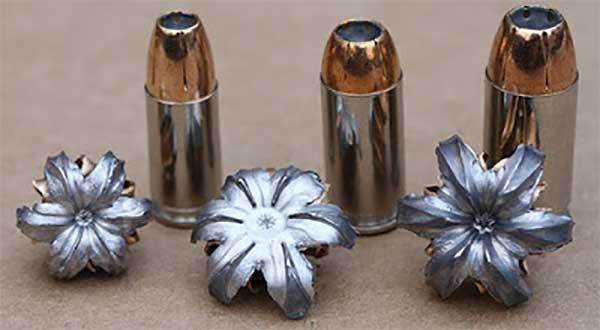
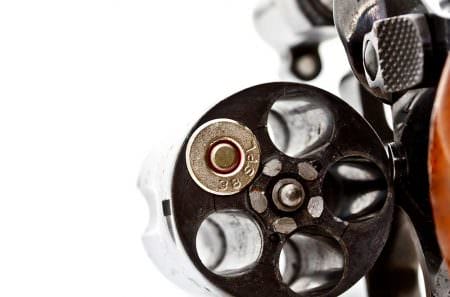
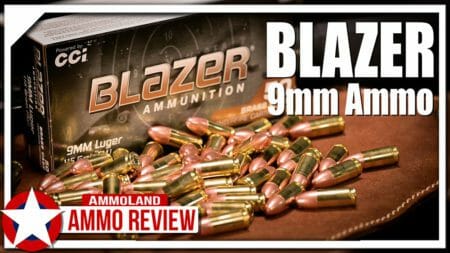
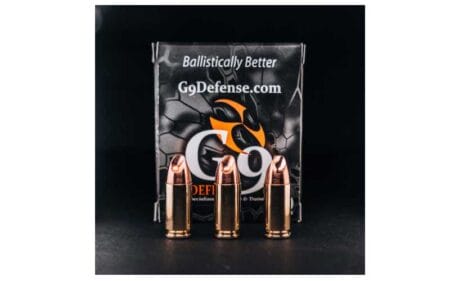
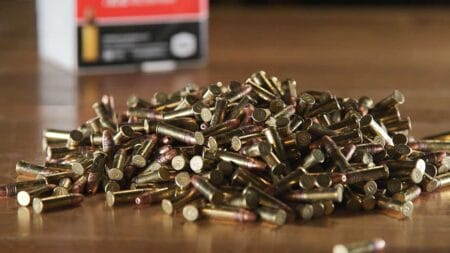
Lots of stats on the 9mm, but nothing about the ammo that blows the lungs out of the body…
Always get the ammo that most haunts the liberal. The kind that “explodes inside people”.
And use an AR 15 which shoots a 5.56 round at 5 times the velocity of other guns!
And shoots it at 300 rounds per minute with a fully automatic clip.
Appears to be a lot of jocularity going on around here.
No respect for those bullet haters – no respect!
Amongst the obvious truths in this article are quite a few errors, e.g. the spread of shot, especially 00 Buck, is minimal at normal self defense distances and over penetration is more likely than with many handgun loads.
On a humorous note: Sometimes 9mm hollow points fail to expand but .45 ACP never gets any smaller.
LOL “Sometimes 9mm hollow points fail to expand, but .45 ACP never gets any smaller.” …truth to power
I pretty much stick with Hornady Defense ammo in my handguns and 20 gauge shotguns. Something to keep in mind when it comes to the self defense ammo vs range ammo argument. My guess is far more people have been killed with FMJ ammo. Than all the self defense ammo being carried currently.
FMJ has one big advantage over all of the “self-defense ammo” and that is reliability. In some states hollow point bullets are illegal.
And contrary to popular belief you have to practice with the ammunition you are going to use, especially in a semiautomatic pistol, for proficiency as well as reliability.
Only one state bans hollow points — that is New Jersey — but interestingly enough they don’t consider ballistic tip rounds like Hornady Critical Defense 9mm to be hollow points because the point is filled with plastic so it isn’t hollow!
When the wife and I were in training to get our CCW, the police told us to use what they use. Hornaday Critical Defense because if an attorney wants to make it look like you are out to get someone with a killer round, it’s the same thing that the police use. Somehow it shows that you are not doing more than those who serve and protect do and use.
Oregoneistan
I really don’t understand the overpenetration argument. A great percentage of bullets fired in self-defense miss their target, making the question of overpenetration wholly irrelevant. Any hollow point has the potential to fail to expand, and behave similarly to a FMJ. An assailant may be very skinny, or a bullet may strike a narrower portion of their body than the torso, such as the neck or an extremity, which may not stop a bullet. Given these realities, I just can’t understand why the issue of overpenetration is given such time in consideration as it currently is given.
Mr. Conroy, where would you place Honeybadger ammo in that lineup (regarding effectiveness?)
I really wonder about pistol ammo effectiveness. I don’t have access to any forensic or police database, but in places like the NRA’s Armed Citzen column, I noticed that in many – perhaps most – of the cases of defensive gun use the bad guy survives; often he doesn’t drop, but runs off and shows up at the hospital. We don’t know ammo details or bullet placement but it still makes you go “Hmmm.” Stopping power? Phooey. As for myself, IMHO whatever premium defensive load from a major manufacturer works 100% in MY particular gun is as good a choice… Read more »
Something to ponder regarding defensive ammo selection. Friend wounded a large buck. We trailed it for almost a mile, found it alive, down in creek, 30ft high banks both sides. Pulled my EDC Kimber Micro 9 with Federal defense ammo. Shot it three times, ….neck, heart, head……zero, nada, zilch results, other than a flinch from impact each time. Knife to throat quickly finished the deer. Back at lodge skinning, found all three rounds picture-perfect beautifully mushroomed as advertised…BURIED IN THE HAIR OF THE HIDE, ZERO PENETRATION….DIDN’T EVEN BREAK THE HIDE. So much for defensive ammo. Would have had the same… Read more »
No mention at all about the “new” solid monolithic rounds. After seeing many many many properly executed ballistics tests I found these rounds suited my defense needs. I now use the Underwood Xtreme Defender rounds in my .40 and 9mm as well as my lady’s .38 Special.
Simply my preference but I wonder why no mention in the article.
“Birdshot or target loads, often used in shotguns, lack the necessary stopping power for home defense compared to buckshot or slugs.”
Yeah – No. At 20ft, roughly 7 yards – I seriously doubt any intruder would “prefer” to be hit upper or lower body with #6 or #7 shot out of a 12ga versus being shot with a 9mm. Hell, a .22 LR Stinger into most areas of the body would stop all but the most dedicated junkies.
Of all the experts pontificating about birdshot as a defensive shotgun round, I notice that only one of them has ever actually fired birdshot at realistic defensive distances to see what the effects would be.
https://www.youtube.com/watch?v=zaR1EVybUgc